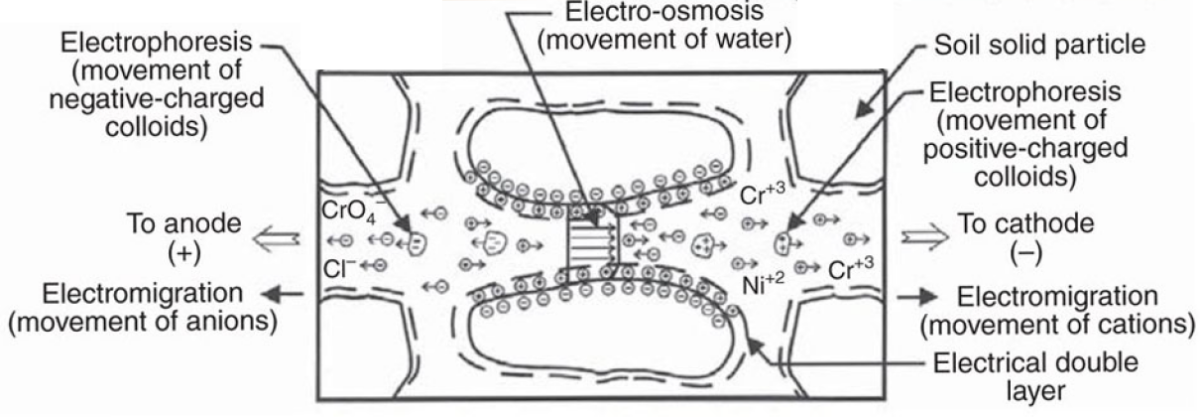Electrokinetic remediation
Electrokinetic remediation is a technology for removing organic and inorganic contaminants, such as heavy metals, from soils and sediments with low hydraulic conductivity.
Electrokinetic remediation is based on the application of a low-intensity electric field to mobilize and remove contaminants. Among the several available treatment options, electrokinetic remediation is recognized as the most suitable for low permeability porous matrices. It can be applied both in situ and ex situ, for several contaminants, also coupled with other techniques.
In full-scale applications, the electric field is applied by means of electrode assemblies placed inside vertical permeable wells with slotted or porous surfaces inserted into the material to be treated to allow the circulation of chemically conditioned fluids (i.e., electrolytes).
The following figure shows a typical in-situ application of electrokinetic decontamination technology:

The applied electric field induces the movement of pollutants, charged particles, solutes and pore fluid through the porous media toward the electrodes, due to three main transport mechanisms:
- Electroosmosis: the movement of liquid
- Electromigration: the transport of charged ions or ion-complexes in solution
- Electrophoresis: the movement of charged particles or colloids
The application of an electric field to a porous matrix also results in a series of complex effects that modify the chemistry of the system.
Modelling of these processes is often a complex task due to the large number of interrelated parameters and processes. The complexity involved is mostly due to the high non-linearity and transient geochemistry that develops during remediation. This is one of the main reasons for the limited implementation of electrokinetic technology at the field scale.
Numerical modelling aims to address these gaps in an effort to build a tool to support evaluation, design and optimization of electrokinetic remediation systems.
Objectives
- Develop a model for simulating pollutant removal processes in electrokinetic remediation systems
- Calibrate and validate the model against measurements and experimental data at laboratory and field scales
- Use the model for the design and dimensioning of full-scale electrokinetic remediation systems
Methods
The main modelled phenomena are: (1) the transport of pollutants by diffusion, electromigration and electroosmosis, (2) the interaction between the pollutant and the soil (surface reactions, precipitation, dissolution, speciation of chemical species and their interactions), (3) reactions occurring at the electrodes (e.g., water electrolysis). The computation of geochemical reactions, both at equilibrium or including kinetics, are simulated in the powerful PHREEQC software with parameters adopted from its extensive database. Transport equations are solved with FEM (finite element method) by using either commercial software (e.g., COMSOL) or open source software (e.g., FEniCS).
Results
Model test and validation
In this study we defined a methodology for the simulation-based design of electrokinetic remediation systems. Starting from the implementation of a numerical model to reproduce laboratory-scale data, a scale-up procedure is accomplished in order to perform the simulation of processes at field scale.

Benefits
The model makes it easy to estimate operating costs to design and optimise the plant.


Read more
Masi, M. (2017). Electrokinetic remediation of heavy metal-contaminated marine sediments: experiments and modelling. PhD Dissertation, University of Pisa. ISBN 978-88-90228-92-6. doi: 10.13131/unipi/etd/01122017-120456
Masi M., Paz-Garcia J. M., Gomez-Lahoz C., Villen-Guzman M., Ceccarini A., Iannelli R. (2019). Modeling of electrokinetic remediation combining local chemical equilibrium and chemical reaction kinetics. Journal of Hazardous Materials, 371, 728-733. doi: 10.1016/j.jhazmat.2019.03.014
Sprocati R., Masi M., Muniruzzaman M., Rolle M. (2019). Modeling electrokinetic transport and biogeochemical reactions in porous media: A multidimensional Nernst–Planck–Poisson approach with PHREEQC coupling. Advances in water resources 127, 134-147. doi: 10.1016/j.advwatres.2019.03.011
Masi M., Ceccarini A., Iannelli R. (2017). Model-based optimization of field-scale electrokinetic treatment of dredged sediments. Chemical Engineering Journal, 328, 87-97. doi: 10.1016/j.cej.2017.07.004
Masi M., Ceccarini A., Iannelli R. (2017). Multispecies reactive transport modelling of electrokinetic remediation of harbour sediments. Journal of Hazardous Materials, 326, 187-196. doi: 10.1016/j.jhazmat.2016.12.032
Masi M., Iannelli R., Losito G. (2016). Ligand-enhanced electrokinetic remediation of metal-contaminated marine sediments with high acid buffering capacity. Environmental Science and Pollution Research, 23, 10566-10576. doi: 10.1007/s11356-015-5563-7
Iannelli R., Masi M., Ceccarini A., Ostuni M.B., Lageman R., Muntoni A., Spiga D., Polettini A., Marini A., Pomi R. (2015). Electrokinetic remediation of metal-polluted marine sediments: experimental investigation for plant design. Electrochimica Acta, 181, 146-159. doi: 10.1016/j.electacta.2015.04.093
Masi M., Losito G. (2015). Spectral induced polarization for monitoring electrokinetic remediation processes. Journal of Applied Geophysics, 123, 284-294. doi: 10.1016/j.jappgeo.2015.08.011







